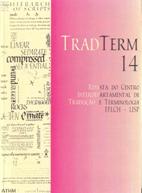Text Linguistics and translation: Redefining the concept of "cultural mark"
DOI:
https://doi.org/10.11606/issn.2317-9511.tradterm.2008.46382Palabras clave:
Text Linguistics, cultural marks, translation teaching.Resumen
Since the works of Nida and Taber (1964, 1969) on the influence of target cultures on texts to be translated, theoretical considerations on the presence of ‘cultural marks’ and consequently on analytical procedures that would serve to identify these marks have been more systematically studied as a result of the so-called ‘cultural turn’ in Translation Studies (Reiss 1971, 1983; Nord 1988, 1993; Snell-Hornby 1986) and heavily criticized by the Deconstruction approach to translation (for instance, Arrojo 1986, 1992). The development of Text Linguistics has also contributed to enlarge the boundaries of the concept, bringing it, so to speak, from the outside world – where it seemed to be embedded in the 60s – to the inner domain of the text itself and discourse. This paper aims at briefly revising this conceptual turn and at discussing its consequences for translation teaching. Examples taken from German texts translated by Brazilian students shall demonstrate how efficient the systematic use of text linguistics concepts can be to help students in identifying layers of meaning which, distant from the idea of ‘cultural marks’ as a reference to a concrete reality, define a point of view in the source text, legitimate interpretations that demand shifts in the target text and therefore can also be taken as cultural in a broader sense.Descargas
Los datos de descarga aún no están disponibles.
Descargas
Publicado
2008-04-18
Número
Sección
Artigos
Licencia
Autores que publicam nesta revista concordam com os seguintes termos:
- Autores mantém os direitos autorais e concedem à revista o direito de primeira publicação, com o trabalho simultaneamente licenciado sob a Licença Creative Commons Attribution BY-NC-SA que permite o compartilhamento do trabalho com reconhecimento da autoria e publicação inicial nesta revista.
- Autores têm autorização para assumir contratos adicionais separadamente, para distribuição não-exclusiva da versão do trabalho publicada nesta revista (ex.: publicar em repositório institucional ou como capítulo de livro), com reconhecimento de autoria e publicação inicial nesta revista.
- Autores têm permissão e são estimulados a publicar e distribuir seu trabalho online (ex.: em repositórios institucionais ou na sua página pessoal) a qualquer ponto antes ou durante o processo editorial, já que isso pode gerar alterações produtivas, bem como aumentar o impacto e a citação do trabalho publicado (Veja O Efeito do Acesso Livre).
Cómo citar
Azenha Júnior, J. (2008). Text Linguistics and translation: Redefining the concept of "cultural mark". Tradterm, 14, 51-68. https://doi.org/10.11606/issn.2317-9511.tradterm.2008.46382


